Business Strategy Recommendations for Woolworths' New Business Unit
VerifiedAdded on 2020/05/11
|18
|3738
|402
Report
AI Summary
This report provides a strategic analysis of Woolworths' new transportation and storage business unit (SBU). It examines business-level strategies, including cost leadership, differentiation, and focus strategies, recommending a combination of cost leadership and differentiation to gain a competitive advantage. The report also explores global strategies, advocating for a transnational approach that balances global standardization and local responsiveness. Furthermore, it delves into organizational structure, suggesting a flat structure to foster communication, empower employees, and enhance efficiency. The analysis highlights key considerations for Woolworths' strategic success in this new venture, including the adoption of appropriate strategies for market competitiveness. The report concludes with specific recommendations for Woolworths to successfully enter the transportation and storage market.
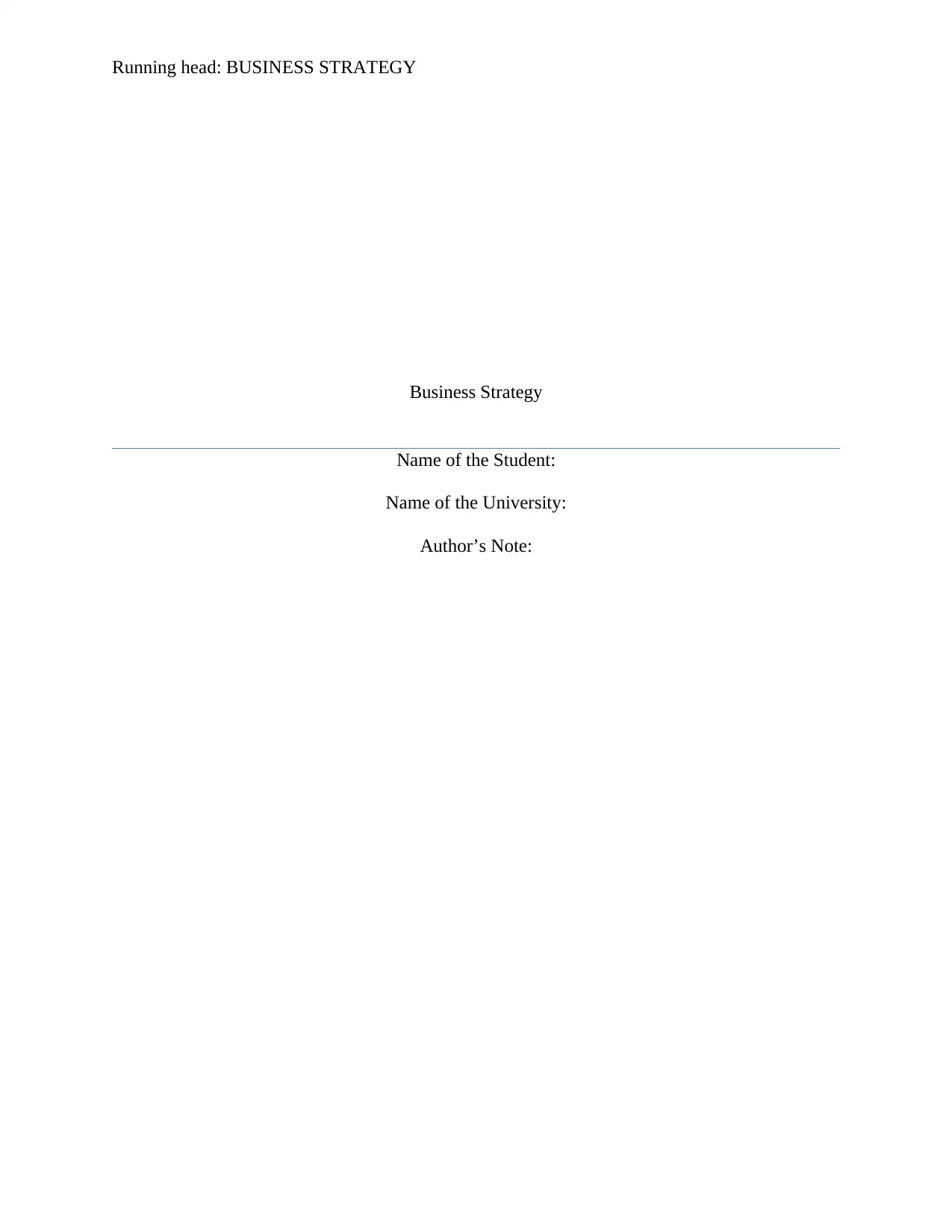
Running head: BUSINESS STRATEGY
Business Strategy
Name of the Student:
Name of the University:
Author’s Note:
Business Strategy
Name of the Student:
Name of the University:
Author’s Note:
Paraphrase This Document
Need a fresh take? Get an instant paraphrase of this document with our AI Paraphraser
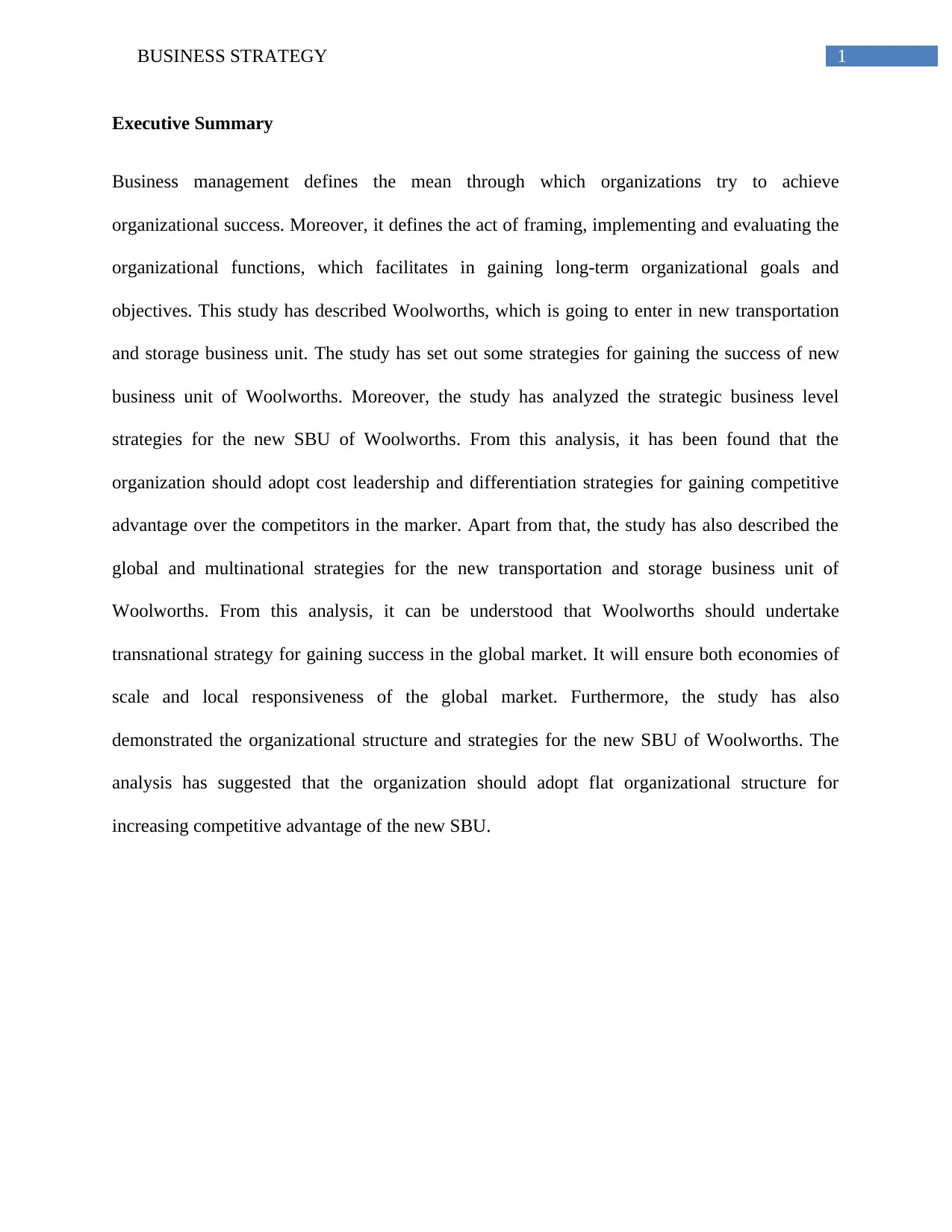
1BUSINESS STRATEGY
Executive Summary
Business management defines the mean through which organizations try to achieve
organizational success. Moreover, it defines the act of framing, implementing and evaluating the
organizational functions, which facilitates in gaining long-term organizational goals and
objectives. This study has described Woolworths, which is going to enter in new transportation
and storage business unit. The study has set out some strategies for gaining the success of new
business unit of Woolworths. Moreover, the study has analyzed the strategic business level
strategies for the new SBU of Woolworths. From this analysis, it has been found that the
organization should adopt cost leadership and differentiation strategies for gaining competitive
advantage over the competitors in the marker. Apart from that, the study has also described the
global and multinational strategies for the new transportation and storage business unit of
Woolworths. From this analysis, it can be understood that Woolworths should undertake
transnational strategy for gaining success in the global market. It will ensure both economies of
scale and local responsiveness of the global market. Furthermore, the study has also
demonstrated the organizational structure and strategies for the new SBU of Woolworths. The
analysis has suggested that the organization should adopt flat organizational structure for
increasing competitive advantage of the new SBU.
Executive Summary
Business management defines the mean through which organizations try to achieve
organizational success. Moreover, it defines the act of framing, implementing and evaluating the
organizational functions, which facilitates in gaining long-term organizational goals and
objectives. This study has described Woolworths, which is going to enter in new transportation
and storage business unit. The study has set out some strategies for gaining the success of new
business unit of Woolworths. Moreover, the study has analyzed the strategic business level
strategies for the new SBU of Woolworths. From this analysis, it has been found that the
organization should adopt cost leadership and differentiation strategies for gaining competitive
advantage over the competitors in the marker. Apart from that, the study has also described the
global and multinational strategies for the new transportation and storage business unit of
Woolworths. From this analysis, it can be understood that Woolworths should undertake
transnational strategy for gaining success in the global market. It will ensure both economies of
scale and local responsiveness of the global market. Furthermore, the study has also
demonstrated the organizational structure and strategies for the new SBU of Woolworths. The
analysis has suggested that the organization should adopt flat organizational structure for
increasing competitive advantage of the new SBU.
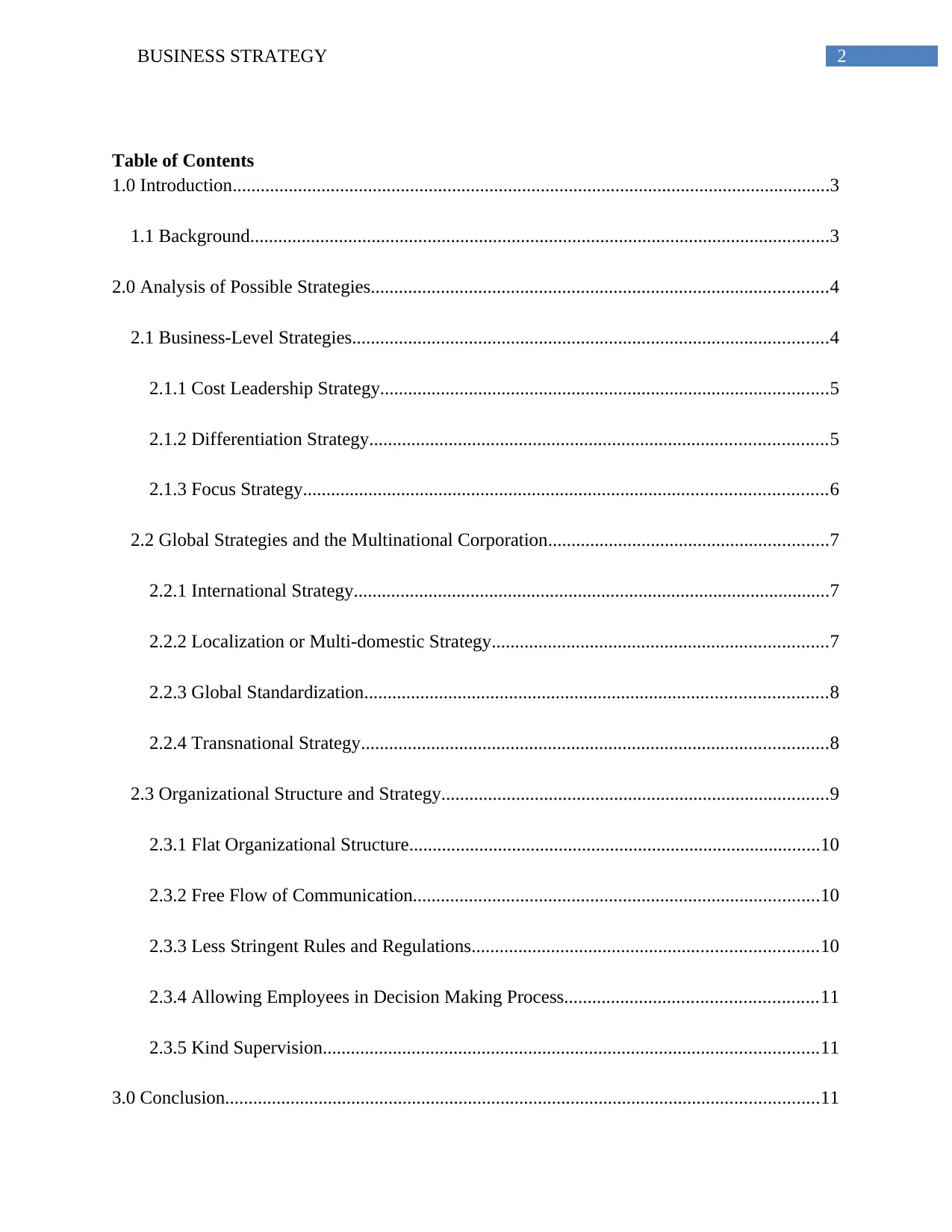
2BUSINESS STRATEGY
Table of Contents
1.0 Introduction................................................................................................................................3
1.1 Background............................................................................................................................3
2.0 Analysis of Possible Strategies..................................................................................................4
2.1 Business-Level Strategies......................................................................................................4
2.1.1 Cost Leadership Strategy................................................................................................5
2.1.2 Differentiation Strategy..................................................................................................5
2.1.3 Focus Strategy................................................................................................................6
2.2 Global Strategies and the Multinational Corporation............................................................7
2.2.1 International Strategy......................................................................................................7
2.2.2 Localization or Multi-domestic Strategy........................................................................7
2.2.3 Global Standardization...................................................................................................8
2.2.4 Transnational Strategy....................................................................................................8
2.3 Organizational Structure and Strategy...................................................................................9
2.3.1 Flat Organizational Structure........................................................................................10
2.3.2 Free Flow of Communication.......................................................................................10
2.3.3 Less Stringent Rules and Regulations..........................................................................10
2.3.4 Allowing Employees in Decision Making Process......................................................11
2.3.5 Kind Supervision..........................................................................................................11
3.0 Conclusion...............................................................................................................................11
Table of Contents
1.0 Introduction................................................................................................................................3
1.1 Background............................................................................................................................3
2.0 Analysis of Possible Strategies..................................................................................................4
2.1 Business-Level Strategies......................................................................................................4
2.1.1 Cost Leadership Strategy................................................................................................5
2.1.2 Differentiation Strategy..................................................................................................5
2.1.3 Focus Strategy................................................................................................................6
2.2 Global Strategies and the Multinational Corporation............................................................7
2.2.1 International Strategy......................................................................................................7
2.2.2 Localization or Multi-domestic Strategy........................................................................7
2.2.3 Global Standardization...................................................................................................8
2.2.4 Transnational Strategy....................................................................................................8
2.3 Organizational Structure and Strategy...................................................................................9
2.3.1 Flat Organizational Structure........................................................................................10
2.3.2 Free Flow of Communication.......................................................................................10
2.3.3 Less Stringent Rules and Regulations..........................................................................10
2.3.4 Allowing Employees in Decision Making Process......................................................11
2.3.5 Kind Supervision..........................................................................................................11
3.0 Conclusion...............................................................................................................................11
⊘ This is a preview!⊘
Do you want full access?
Subscribe today to unlock all pages.

Trusted by 1+ million students worldwide
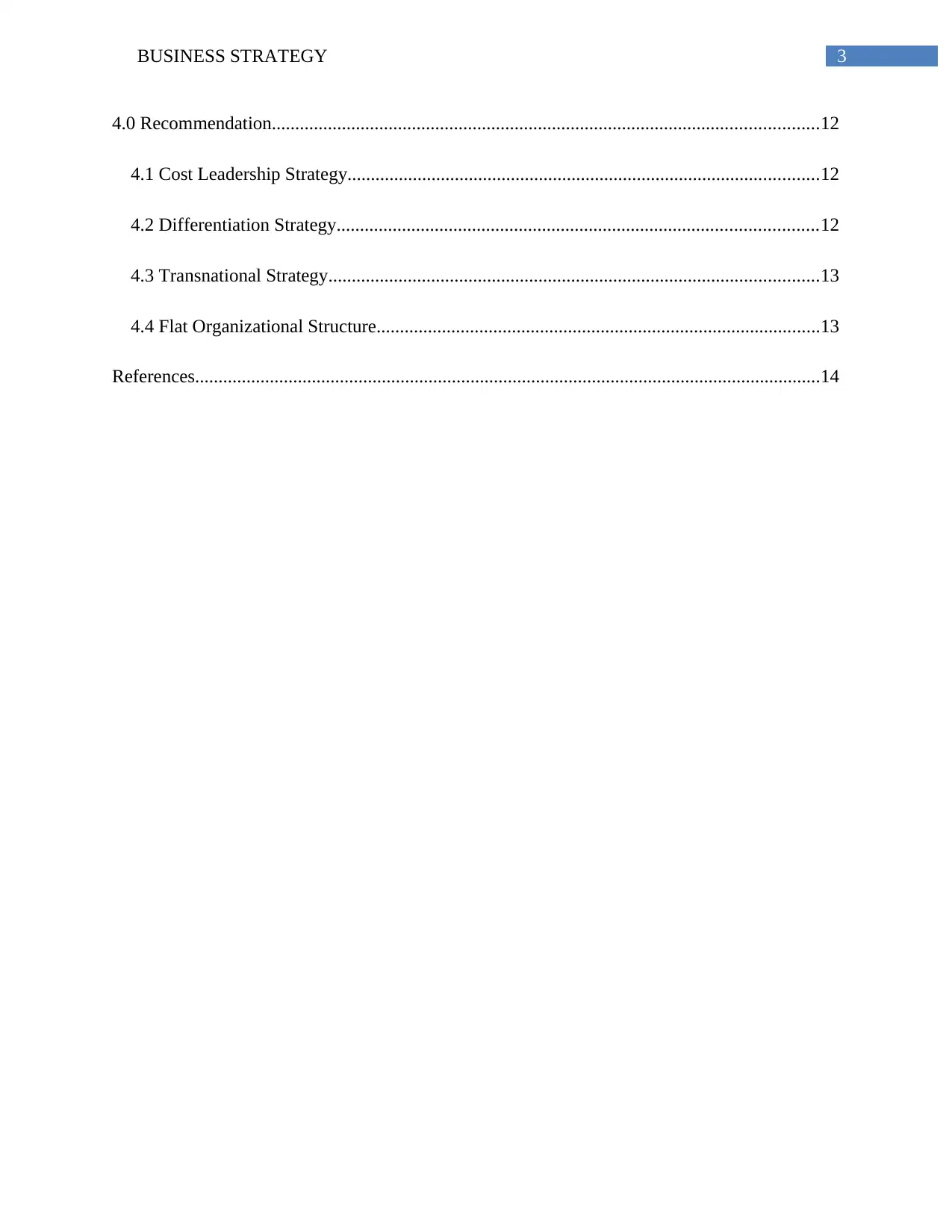
3BUSINESS STRATEGY
4.0 Recommendation.....................................................................................................................12
4.1 Cost Leadership Strategy.....................................................................................................12
4.2 Differentiation Strategy.......................................................................................................12
4.3 Transnational Strategy.........................................................................................................13
4.4 Flat Organizational Structure...............................................................................................13
References......................................................................................................................................14
4.0 Recommendation.....................................................................................................................12
4.1 Cost Leadership Strategy.....................................................................................................12
4.2 Differentiation Strategy.......................................................................................................12
4.3 Transnational Strategy.........................................................................................................13
4.4 Flat Organizational Structure...............................................................................................13
References......................................................................................................................................14
Paraphrase This Document
Need a fresh take? Get an instant paraphrase of this document with our AI Paraphraser
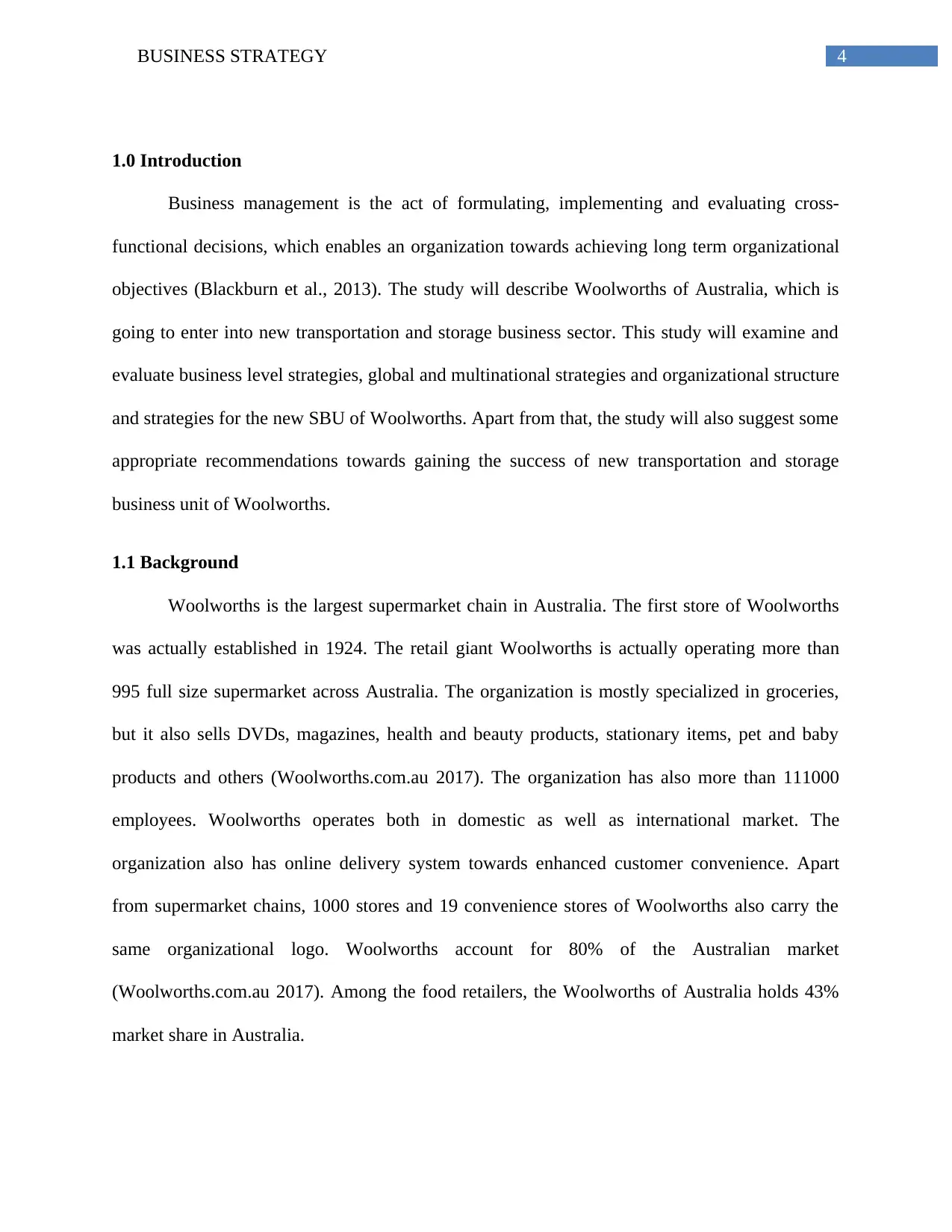
4BUSINESS STRATEGY
1.0 Introduction
Business management is the act of formulating, implementing and evaluating cross-
functional decisions, which enables an organization towards achieving long term organizational
objectives (Blackburn et al., 2013). The study will describe Woolworths of Australia, which is
going to enter into new transportation and storage business sector. This study will examine and
evaluate business level strategies, global and multinational strategies and organizational structure
and strategies for the new SBU of Woolworths. Apart from that, the study will also suggest some
appropriate recommendations towards gaining the success of new transportation and storage
business unit of Woolworths.
1.1 Background
Woolworths is the largest supermarket chain in Australia. The first store of Woolworths
was actually established in 1924. The retail giant Woolworths is actually operating more than
995 full size supermarket across Australia. The organization is mostly specialized in groceries,
but it also sells DVDs, magazines, health and beauty products, stationary items, pet and baby
products and others (Woolworths.com.au 2017). The organization has also more than 111000
employees. Woolworths operates both in domestic as well as international market. The
organization also has online delivery system towards enhanced customer convenience. Apart
from supermarket chains, 1000 stores and 19 convenience stores of Woolworths also carry the
same organizational logo. Woolworths account for 80% of the Australian market
(Woolworths.com.au 2017). Among the food retailers, the Woolworths of Australia holds 43%
market share in Australia.
1.0 Introduction
Business management is the act of formulating, implementing and evaluating cross-
functional decisions, which enables an organization towards achieving long term organizational
objectives (Blackburn et al., 2013). The study will describe Woolworths of Australia, which is
going to enter into new transportation and storage business sector. This study will examine and
evaluate business level strategies, global and multinational strategies and organizational structure
and strategies for the new SBU of Woolworths. Apart from that, the study will also suggest some
appropriate recommendations towards gaining the success of new transportation and storage
business unit of Woolworths.
1.1 Background
Woolworths is the largest supermarket chain in Australia. The first store of Woolworths
was actually established in 1924. The retail giant Woolworths is actually operating more than
995 full size supermarket across Australia. The organization is mostly specialized in groceries,
but it also sells DVDs, magazines, health and beauty products, stationary items, pet and baby
products and others (Woolworths.com.au 2017). The organization has also more than 111000
employees. Woolworths operates both in domestic as well as international market. The
organization also has online delivery system towards enhanced customer convenience. Apart
from supermarket chains, 1000 stores and 19 convenience stores of Woolworths also carry the
same organizational logo. Woolworths account for 80% of the Australian market
(Woolworths.com.au 2017). Among the food retailers, the Woolworths of Australia holds 43%
market share in Australia.
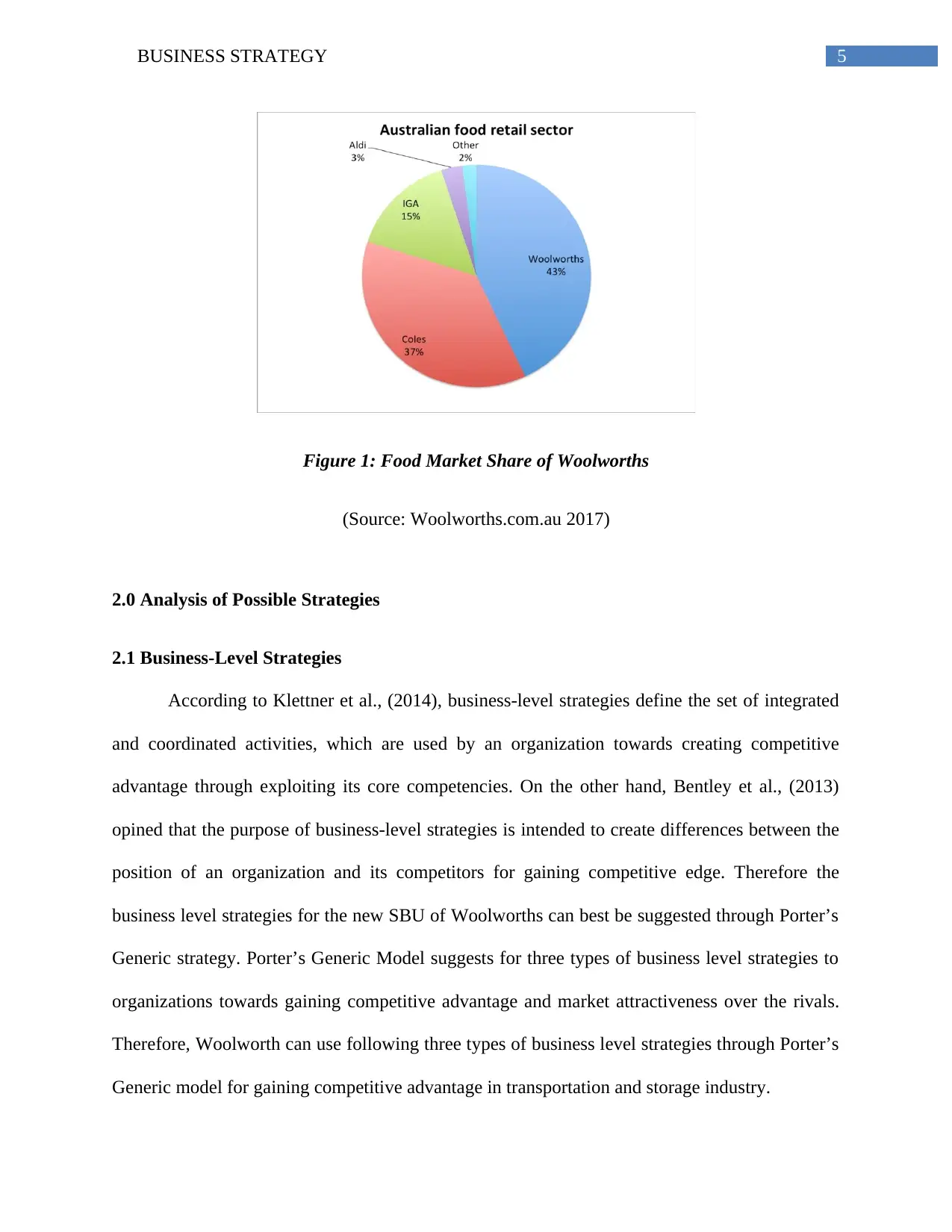
5BUSINESS STRATEGY
Figure 1: Food Market Share of Woolworths
(Source: Woolworths.com.au 2017)
2.0 Analysis of Possible Strategies
2.1 Business-Level Strategies
According to Klettner et al., (2014), business-level strategies define the set of integrated
and coordinated activities, which are used by an organization towards creating competitive
advantage through exploiting its core competencies. On the other hand, Bentley et al., (2013)
opined that the purpose of business-level strategies is intended to create differences between the
position of an organization and its competitors for gaining competitive edge. Therefore the
business level strategies for the new SBU of Woolworths can best be suggested through Porter’s
Generic strategy. Porter’s Generic Model suggests for three types of business level strategies to
organizations towards gaining competitive advantage and market attractiveness over the rivals.
Therefore, Woolworth can use following three types of business level strategies through Porter’s
Generic model for gaining competitive advantage in transportation and storage industry.
Figure 1: Food Market Share of Woolworths
(Source: Woolworths.com.au 2017)
2.0 Analysis of Possible Strategies
2.1 Business-Level Strategies
According to Klettner et al., (2014), business-level strategies define the set of integrated
and coordinated activities, which are used by an organization towards creating competitive
advantage through exploiting its core competencies. On the other hand, Bentley et al., (2013)
opined that the purpose of business-level strategies is intended to create differences between the
position of an organization and its competitors for gaining competitive edge. Therefore the
business level strategies for the new SBU of Woolworths can best be suggested through Porter’s
Generic strategy. Porter’s Generic Model suggests for three types of business level strategies to
organizations towards gaining competitive advantage and market attractiveness over the rivals.
Therefore, Woolworth can use following three types of business level strategies through Porter’s
Generic model for gaining competitive advantage in transportation and storage industry.
⊘ This is a preview!⊘
Do you want full access?
Subscribe today to unlock all pages.

Trusted by 1+ million students worldwide
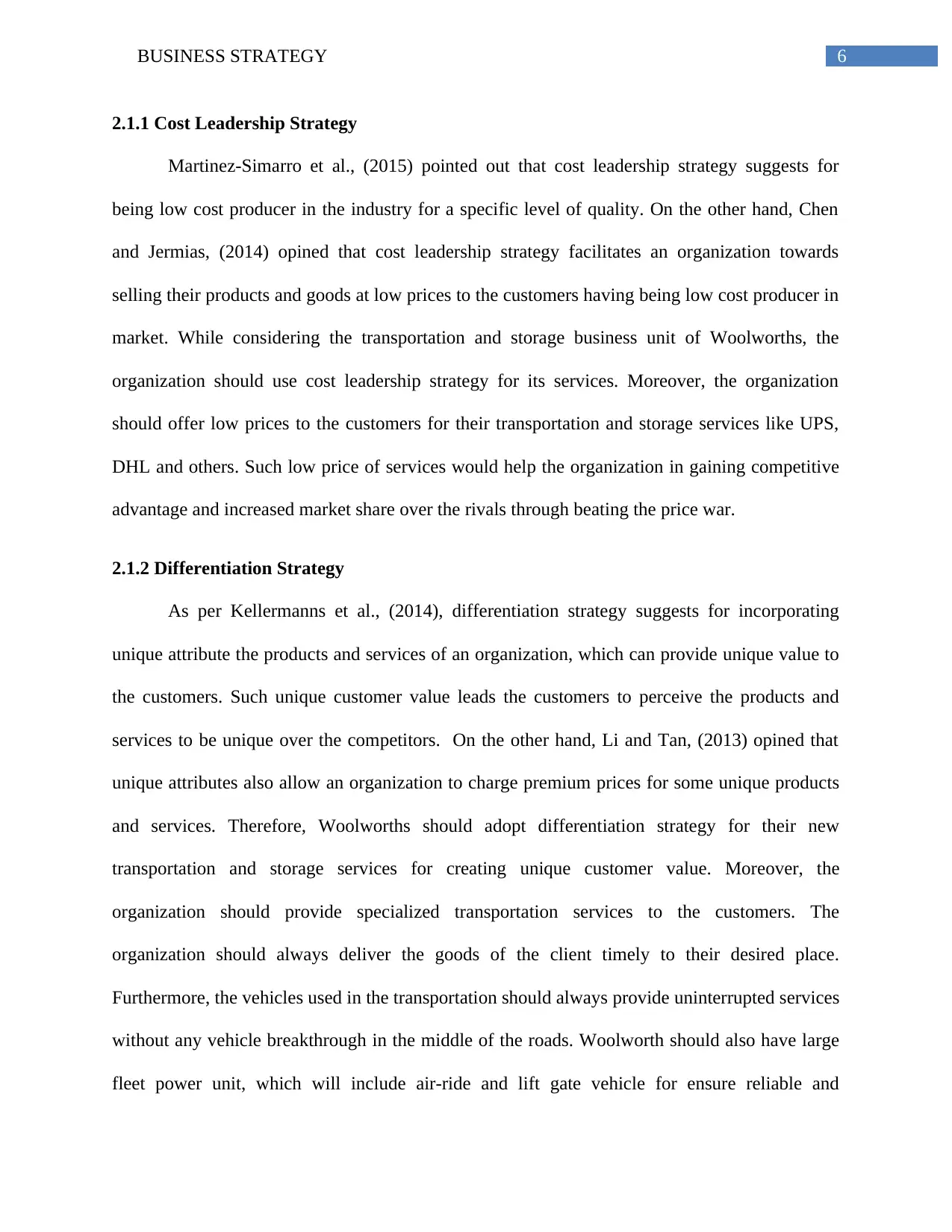
6BUSINESS STRATEGY
2.1.1 Cost Leadership Strategy
Martinez-Simarro et al., (2015) pointed out that cost leadership strategy suggests for
being low cost producer in the industry for a specific level of quality. On the other hand, Chen
and Jermias, (2014) opined that cost leadership strategy facilitates an organization towards
selling their products and goods at low prices to the customers having being low cost producer in
market. While considering the transportation and storage business unit of Woolworths, the
organization should use cost leadership strategy for its services. Moreover, the organization
should offer low prices to the customers for their transportation and storage services like UPS,
DHL and others. Such low price of services would help the organization in gaining competitive
advantage and increased market share over the rivals through beating the price war.
2.1.2 Differentiation Strategy
As per Kellermanns et al., (2014), differentiation strategy suggests for incorporating
unique attribute the products and services of an organization, which can provide unique value to
the customers. Such unique customer value leads the customers to perceive the products and
services to be unique over the competitors. On the other hand, Li and Tan, (2013) opined that
unique attributes also allow an organization to charge premium prices for some unique products
and services. Therefore, Woolworths should adopt differentiation strategy for their new
transportation and storage services for creating unique customer value. Moreover, the
organization should provide specialized transportation services to the customers. The
organization should always deliver the goods of the client timely to their desired place.
Furthermore, the vehicles used in the transportation should always provide uninterrupted services
without any vehicle breakthrough in the middle of the roads. Woolworth should also have large
fleet power unit, which will include air-ride and lift gate vehicle for ensure reliable and
2.1.1 Cost Leadership Strategy
Martinez-Simarro et al., (2015) pointed out that cost leadership strategy suggests for
being low cost producer in the industry for a specific level of quality. On the other hand, Chen
and Jermias, (2014) opined that cost leadership strategy facilitates an organization towards
selling their products and goods at low prices to the customers having being low cost producer in
market. While considering the transportation and storage business unit of Woolworths, the
organization should use cost leadership strategy for its services. Moreover, the organization
should offer low prices to the customers for their transportation and storage services like UPS,
DHL and others. Such low price of services would help the organization in gaining competitive
advantage and increased market share over the rivals through beating the price war.
2.1.2 Differentiation Strategy
As per Kellermanns et al., (2014), differentiation strategy suggests for incorporating
unique attribute the products and services of an organization, which can provide unique value to
the customers. Such unique customer value leads the customers to perceive the products and
services to be unique over the competitors. On the other hand, Li and Tan, (2013) opined that
unique attributes also allow an organization to charge premium prices for some unique products
and services. Therefore, Woolworths should adopt differentiation strategy for their new
transportation and storage services for creating unique customer value. Moreover, the
organization should provide specialized transportation services to the customers. The
organization should always deliver the goods of the client timely to their desired place.
Furthermore, the vehicles used in the transportation should always provide uninterrupted services
without any vehicle breakthrough in the middle of the roads. Woolworth should also have large
fleet power unit, which will include air-ride and lift gate vehicle for ensure reliable and
Paraphrase This Document
Need a fresh take? Get an instant paraphrase of this document with our AI Paraphraser
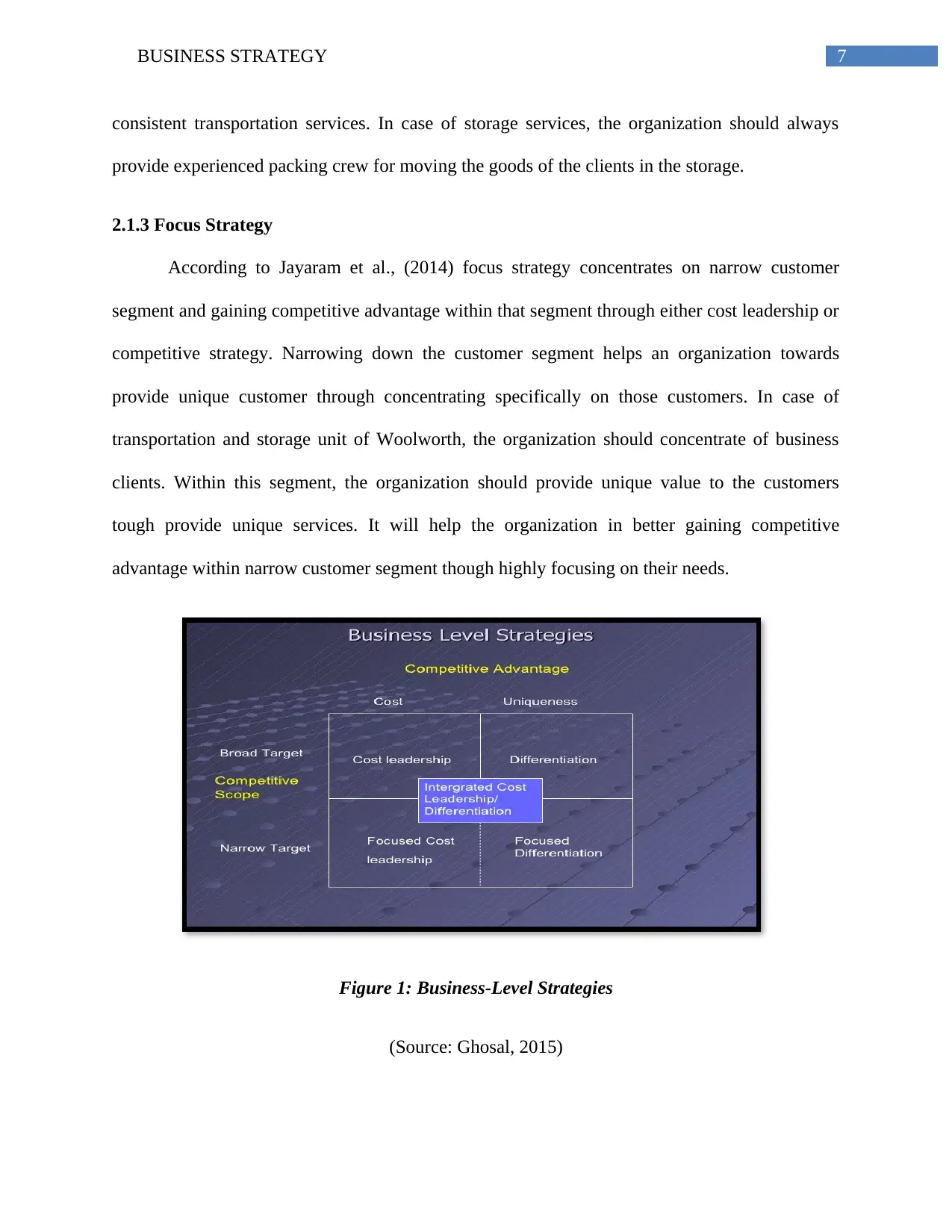
7BUSINESS STRATEGY
consistent transportation services. In case of storage services, the organization should always
provide experienced packing crew for moving the goods of the clients in the storage.
2.1.3 Focus Strategy
According to Jayaram et al., (2014) focus strategy concentrates on narrow customer
segment and gaining competitive advantage within that segment through either cost leadership or
competitive strategy. Narrowing down the customer segment helps an organization towards
provide unique customer through concentrating specifically on those customers. In case of
transportation and storage unit of Woolworth, the organization should concentrate of business
clients. Within this segment, the organization should provide unique value to the customers
tough provide unique services. It will help the organization in better gaining competitive
advantage within narrow customer segment though highly focusing on their needs.
Figure 1: Business-Level Strategies
(Source: Ghosal, 2015)
consistent transportation services. In case of storage services, the organization should always
provide experienced packing crew for moving the goods of the clients in the storage.
2.1.3 Focus Strategy
According to Jayaram et al., (2014) focus strategy concentrates on narrow customer
segment and gaining competitive advantage within that segment through either cost leadership or
competitive strategy. Narrowing down the customer segment helps an organization towards
provide unique customer through concentrating specifically on those customers. In case of
transportation and storage unit of Woolworth, the organization should concentrate of business
clients. Within this segment, the organization should provide unique value to the customers
tough provide unique services. It will help the organization in better gaining competitive
advantage within narrow customer segment though highly focusing on their needs.
Figure 1: Business-Level Strategies
(Source: Ghosal, 2015)
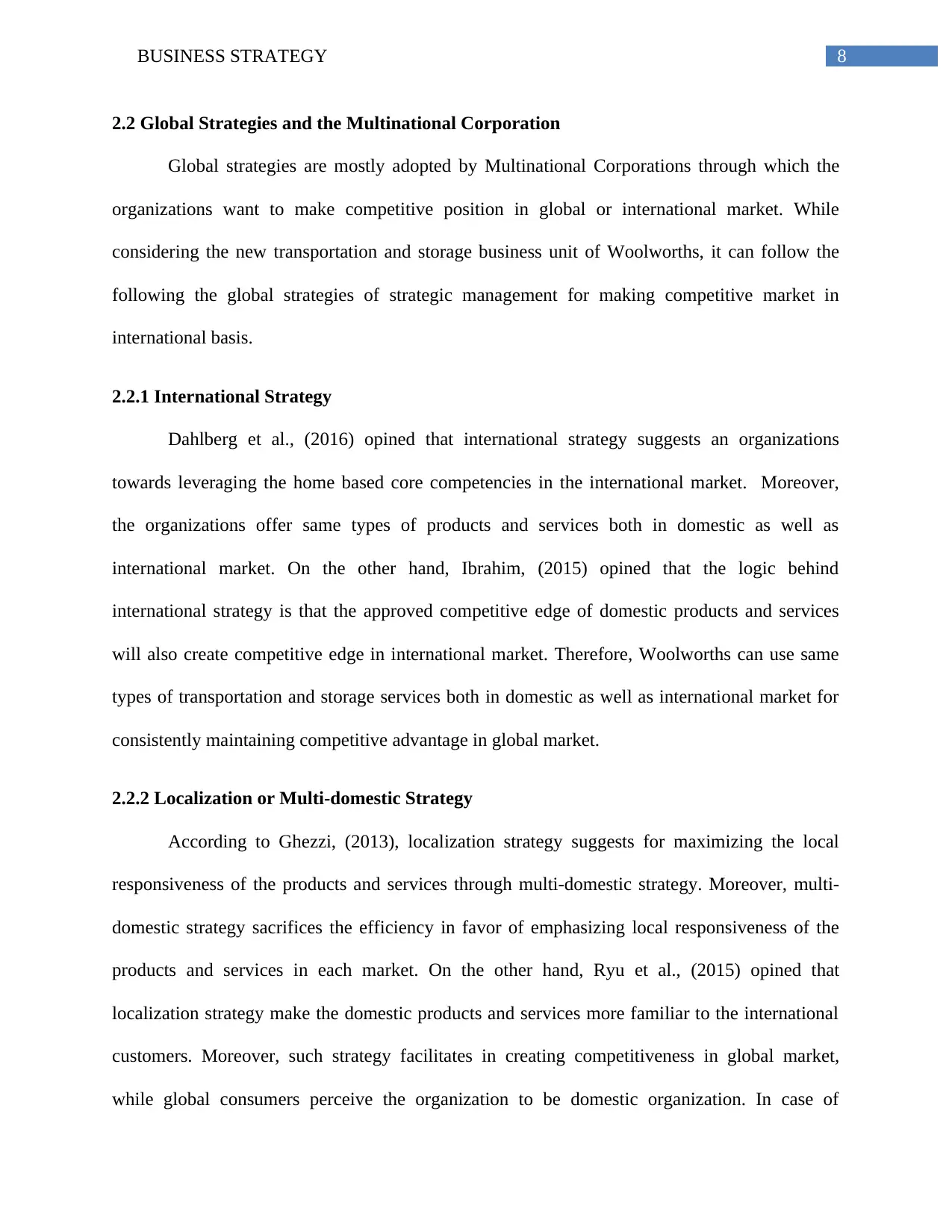
8BUSINESS STRATEGY
2.2 Global Strategies and the Multinational Corporation
Global strategies are mostly adopted by Multinational Corporations through which the
organizations want to make competitive position in global or international market. While
considering the new transportation and storage business unit of Woolworths, it can follow the
following the global strategies of strategic management for making competitive market in
international basis.
2.2.1 International Strategy
Dahlberg et al., (2016) opined that international strategy suggests an organizations
towards leveraging the home based core competencies in the international market. Moreover,
the organizations offer same types of products and services both in domestic as well as
international market. On the other hand, Ibrahim, (2015) opined that the logic behind
international strategy is that the approved competitive edge of domestic products and services
will also create competitive edge in international market. Therefore, Woolworths can use same
types of transportation and storage services both in domestic as well as international market for
consistently maintaining competitive advantage in global market.
2.2.2 Localization or Multi-domestic Strategy
According to Ghezzi, (2013), localization strategy suggests for maximizing the local
responsiveness of the products and services through multi-domestic strategy. Moreover, multi-
domestic strategy sacrifices the efficiency in favor of emphasizing local responsiveness of the
products and services in each market. On the other hand, Ryu et al., (2015) opined that
localization strategy make the domestic products and services more familiar to the international
customers. Moreover, such strategy facilitates in creating competitiveness in global market,
while global consumers perceive the organization to be domestic organization. In case of
2.2 Global Strategies and the Multinational Corporation
Global strategies are mostly adopted by Multinational Corporations through which the
organizations want to make competitive position in global or international market. While
considering the new transportation and storage business unit of Woolworths, it can follow the
following the global strategies of strategic management for making competitive market in
international basis.
2.2.1 International Strategy
Dahlberg et al., (2016) opined that international strategy suggests an organizations
towards leveraging the home based core competencies in the international market. Moreover,
the organizations offer same types of products and services both in domestic as well as
international market. On the other hand, Ibrahim, (2015) opined that the logic behind
international strategy is that the approved competitive edge of domestic products and services
will also create competitive edge in international market. Therefore, Woolworths can use same
types of transportation and storage services both in domestic as well as international market for
consistently maintaining competitive advantage in global market.
2.2.2 Localization or Multi-domestic Strategy
According to Ghezzi, (2013), localization strategy suggests for maximizing the local
responsiveness of the products and services through multi-domestic strategy. Moreover, multi-
domestic strategy sacrifices the efficiency in favor of emphasizing local responsiveness of the
products and services in each market. On the other hand, Ryu et al., (2015) opined that
localization strategy make the domestic products and services more familiar to the international
customers. Moreover, such strategy facilitates in creating competitiveness in global market,
while global consumers perceive the organization to be domestic organization. In case of
⊘ This is a preview!⊘
Do you want full access?
Subscribe today to unlock all pages.

Trusted by 1+ million students worldwide
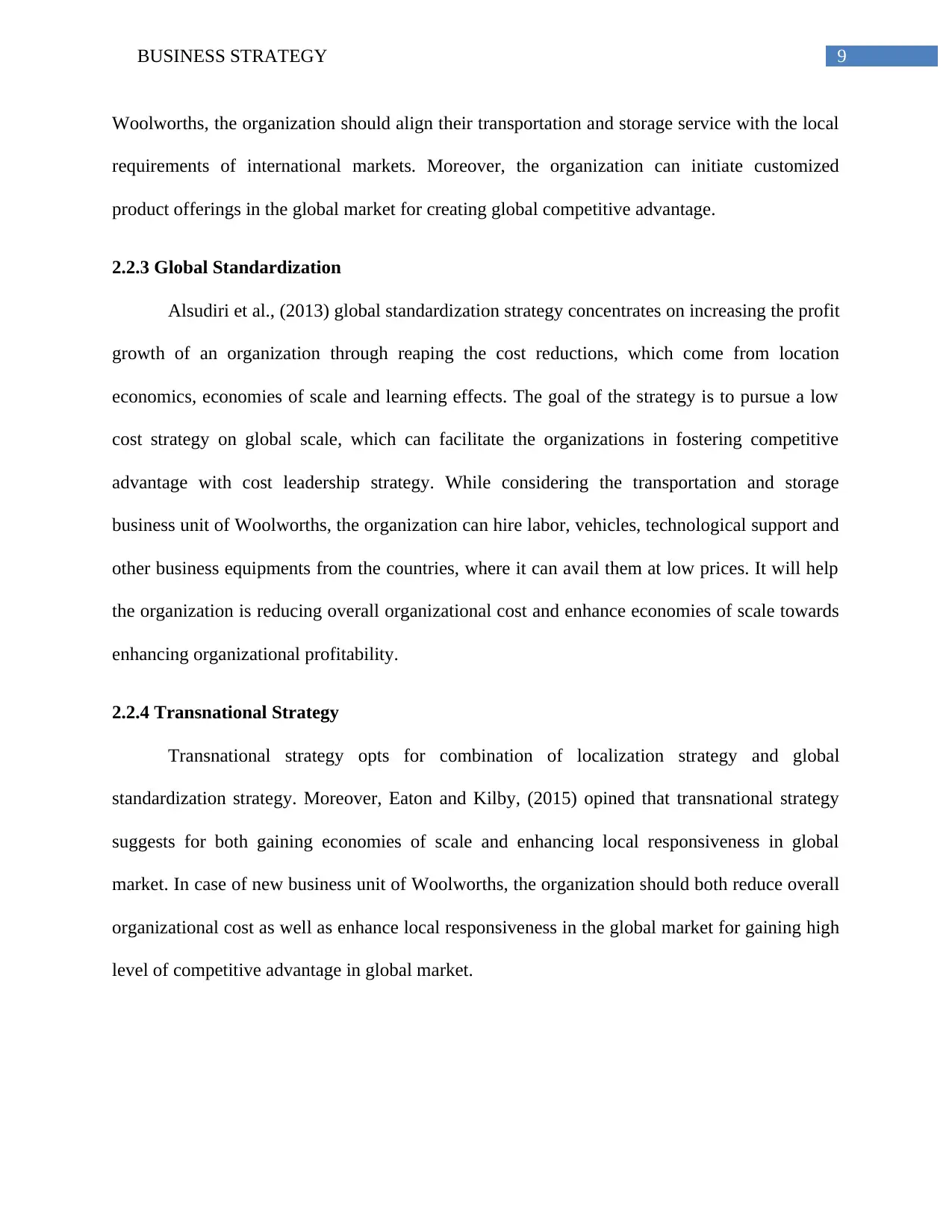
9BUSINESS STRATEGY
Woolworths, the organization should align their transportation and storage service with the local
requirements of international markets. Moreover, the organization can initiate customized
product offerings in the global market for creating global competitive advantage.
2.2.3 Global Standardization
Alsudiri et al., (2013) global standardization strategy concentrates on increasing the profit
growth of an organization through reaping the cost reductions, which come from location
economics, economies of scale and learning effects. The goal of the strategy is to pursue a low
cost strategy on global scale, which can facilitate the organizations in fostering competitive
advantage with cost leadership strategy. While considering the transportation and storage
business unit of Woolworths, the organization can hire labor, vehicles, technological support and
other business equipments from the countries, where it can avail them at low prices. It will help
the organization is reducing overall organizational cost and enhance economies of scale towards
enhancing organizational profitability.
2.2.4 Transnational Strategy
Transnational strategy opts for combination of localization strategy and global
standardization strategy. Moreover, Eaton and Kilby, (2015) opined that transnational strategy
suggests for both gaining economies of scale and enhancing local responsiveness in global
market. In case of new business unit of Woolworths, the organization should both reduce overall
organizational cost as well as enhance local responsiveness in the global market for gaining high
level of competitive advantage in global market.
Woolworths, the organization should align their transportation and storage service with the local
requirements of international markets. Moreover, the organization can initiate customized
product offerings in the global market for creating global competitive advantage.
2.2.3 Global Standardization
Alsudiri et al., (2013) global standardization strategy concentrates on increasing the profit
growth of an organization through reaping the cost reductions, which come from location
economics, economies of scale and learning effects. The goal of the strategy is to pursue a low
cost strategy on global scale, which can facilitate the organizations in fostering competitive
advantage with cost leadership strategy. While considering the transportation and storage
business unit of Woolworths, the organization can hire labor, vehicles, technological support and
other business equipments from the countries, where it can avail them at low prices. It will help
the organization is reducing overall organizational cost and enhance economies of scale towards
enhancing organizational profitability.
2.2.4 Transnational Strategy
Transnational strategy opts for combination of localization strategy and global
standardization strategy. Moreover, Eaton and Kilby, (2015) opined that transnational strategy
suggests for both gaining economies of scale and enhancing local responsiveness in global
market. In case of new business unit of Woolworths, the organization should both reduce overall
organizational cost as well as enhance local responsiveness in the global market for gaining high
level of competitive advantage in global market.
Paraphrase This Document
Need a fresh take? Get an instant paraphrase of this document with our AI Paraphraser
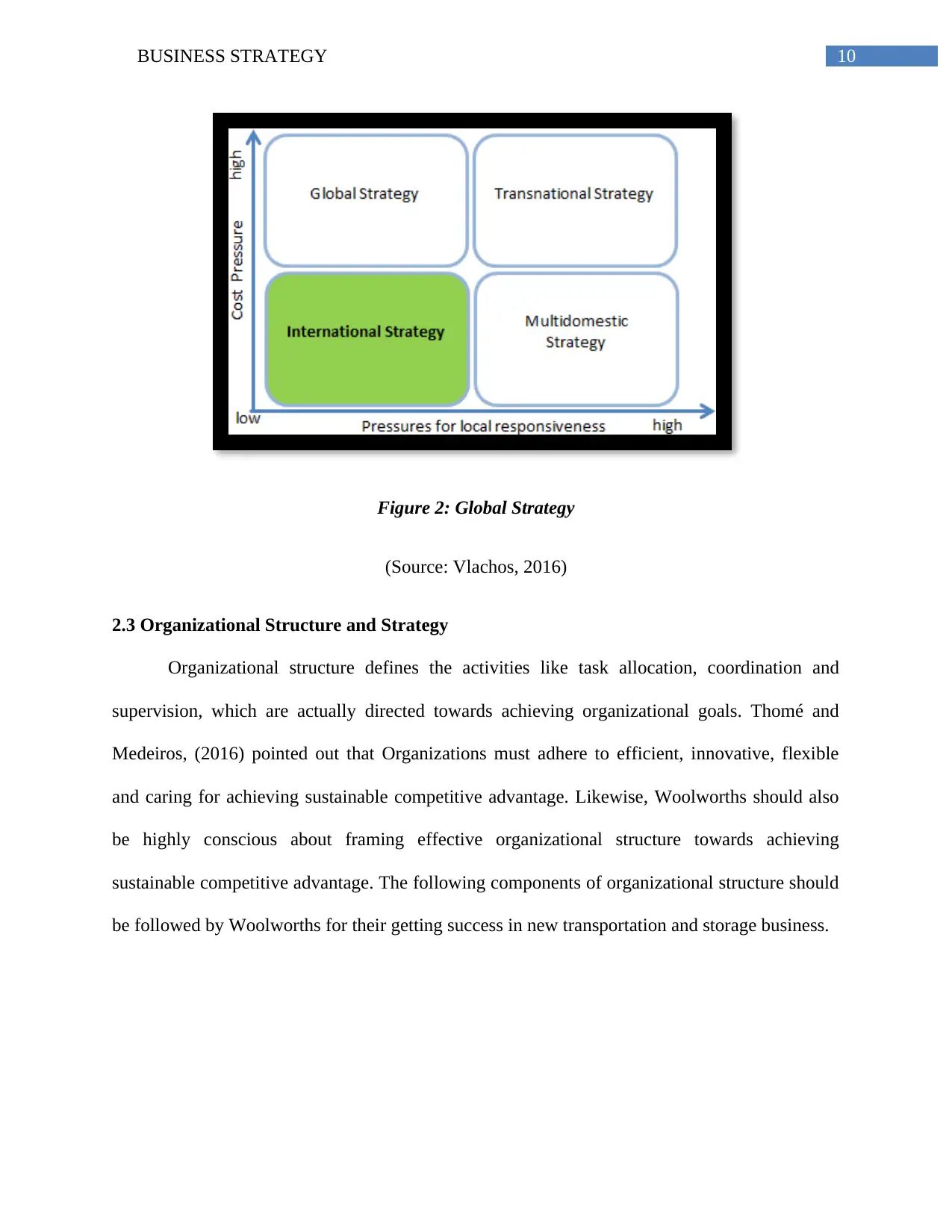
10BUSINESS STRATEGY
Figure 2: Global Strategy
(Source: Vlachos, 2016)
2.3 Organizational Structure and Strategy
Organizational structure defines the activities like task allocation, coordination and
supervision, which are actually directed towards achieving organizational goals. Thomé and
Medeiros, (2016) pointed out that Organizations must adhere to efficient, innovative, flexible
and caring for achieving sustainable competitive advantage. Likewise, Woolworths should also
be highly conscious about framing effective organizational structure towards achieving
sustainable competitive advantage. The following components of organizational structure should
be followed by Woolworths for their getting success in new transportation and storage business.
Figure 2: Global Strategy
(Source: Vlachos, 2016)
2.3 Organizational Structure and Strategy
Organizational structure defines the activities like task allocation, coordination and
supervision, which are actually directed towards achieving organizational goals. Thomé and
Medeiros, (2016) pointed out that Organizations must adhere to efficient, innovative, flexible
and caring for achieving sustainable competitive advantage. Likewise, Woolworths should also
be highly conscious about framing effective organizational structure towards achieving
sustainable competitive advantage. The following components of organizational structure should
be followed by Woolworths for their getting success in new transportation and storage business.
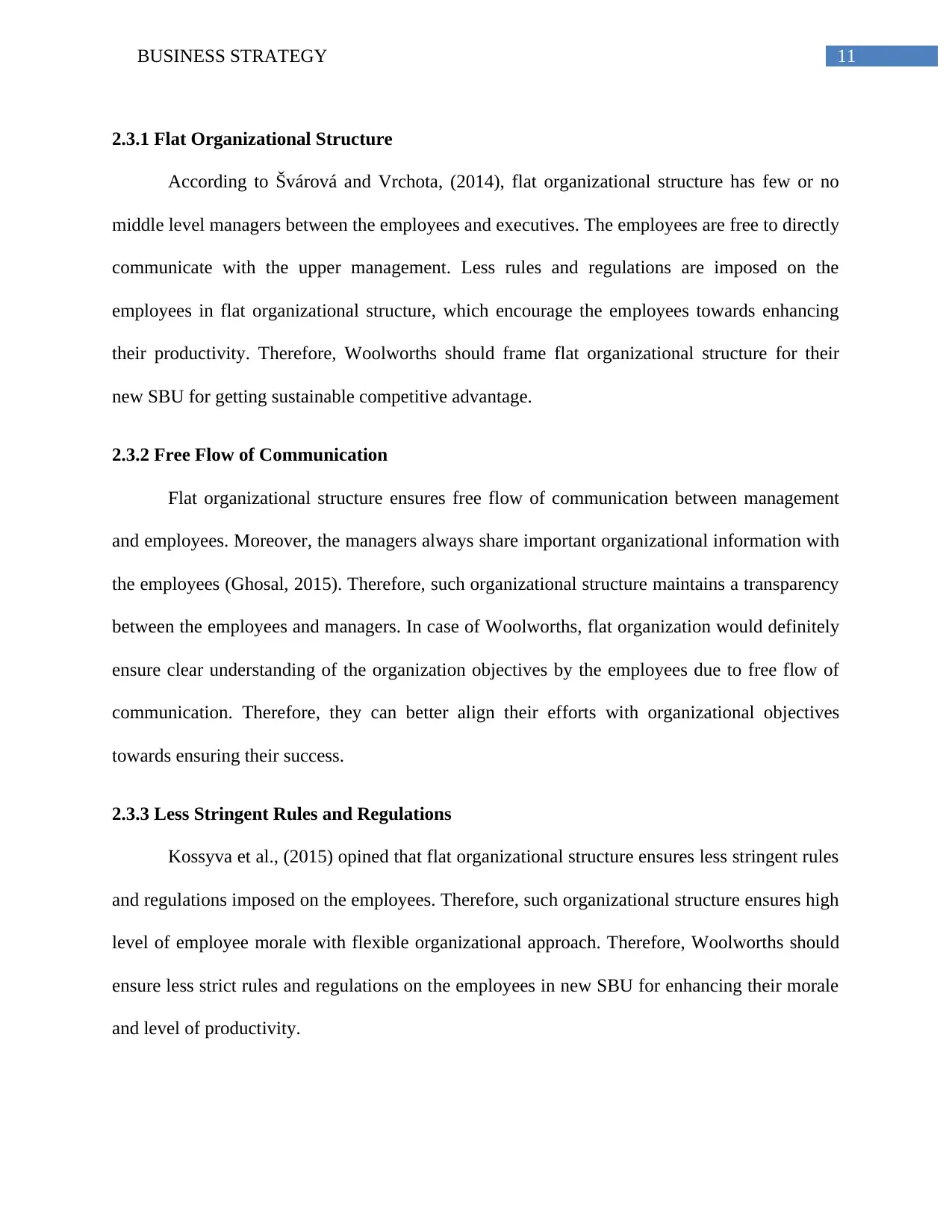
11BUSINESS STRATEGY
2.3.1 Flat Organizational Structure
According to Švárová and Vrchota, (2014), flat organizational structure has few or no
middle level managers between the employees and executives. The employees are free to directly
communicate with the upper management. Less rules and regulations are imposed on the
employees in flat organizational structure, which encourage the employees towards enhancing
their productivity. Therefore, Woolworths should frame flat organizational structure for their
new SBU for getting sustainable competitive advantage.
2.3.2 Free Flow of Communication
Flat organizational structure ensures free flow of communication between management
and employees. Moreover, the managers always share important organizational information with
the employees (Ghosal, 2015). Therefore, such organizational structure maintains a transparency
between the employees and managers. In case of Woolworths, flat organization would definitely
ensure clear understanding of the organization objectives by the employees due to free flow of
communication. Therefore, they can better align their efforts with organizational objectives
towards ensuring their success.
2.3.3 Less Stringent Rules and Regulations
Kossyva et al., (2015) opined that flat organizational structure ensures less stringent rules
and regulations imposed on the employees. Therefore, such organizational structure ensures high
level of employee morale with flexible organizational approach. Therefore, Woolworths should
ensure less strict rules and regulations on the employees in new SBU for enhancing their morale
and level of productivity.
2.3.1 Flat Organizational Structure
According to Švárová and Vrchota, (2014), flat organizational structure has few or no
middle level managers between the employees and executives. The employees are free to directly
communicate with the upper management. Less rules and regulations are imposed on the
employees in flat organizational structure, which encourage the employees towards enhancing
their productivity. Therefore, Woolworths should frame flat organizational structure for their
new SBU for getting sustainable competitive advantage.
2.3.2 Free Flow of Communication
Flat organizational structure ensures free flow of communication between management
and employees. Moreover, the managers always share important organizational information with
the employees (Ghosal, 2015). Therefore, such organizational structure maintains a transparency
between the employees and managers. In case of Woolworths, flat organization would definitely
ensure clear understanding of the organization objectives by the employees due to free flow of
communication. Therefore, they can better align their efforts with organizational objectives
towards ensuring their success.
2.3.3 Less Stringent Rules and Regulations
Kossyva et al., (2015) opined that flat organizational structure ensures less stringent rules
and regulations imposed on the employees. Therefore, such organizational structure ensures high
level of employee morale with flexible organizational approach. Therefore, Woolworths should
ensure less strict rules and regulations on the employees in new SBU for enhancing their morale
and level of productivity.
⊘ This is a preview!⊘
Do you want full access?
Subscribe today to unlock all pages.

Trusted by 1+ million students worldwide
1 out of 18
Related Documents
Your All-in-One AI-Powered Toolkit for Academic Success.
+13062052269
info@desklib.com
Available 24*7 on WhatsApp / Email
![[object Object]](/_next/static/media/star-bottom.7253800d.svg)
Unlock your academic potential
Copyright © 2020–2025 A2Z Services. All Rights Reserved. Developed and managed by ZUCOL.





